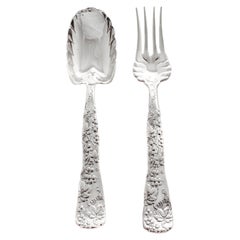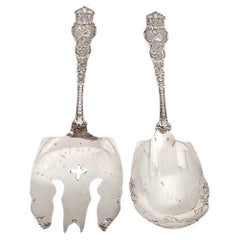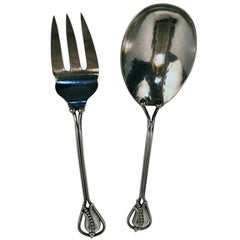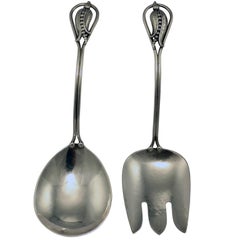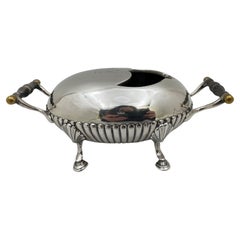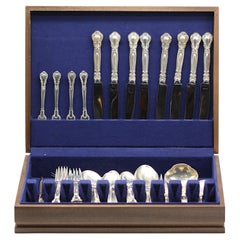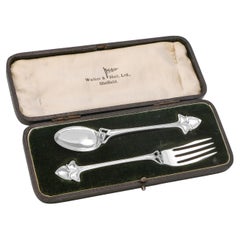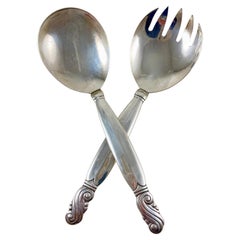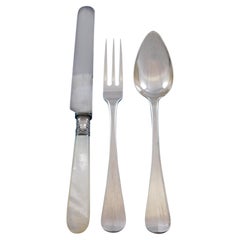Antique Spoons And Forks
1880s American Antique Spoons And Forks
Sterling Silver
19th Century Antique Spoons And Forks
Sterling Silver
Early 20th Century Canadian Antique Spoons And Forks
Silver
Early 20th Century Canadian Antique Spoons And Forks
Silver
1880s English Victorian Antique Spoons And Forks
Silver, Sterling Silver
19th Century Antique Spoons And Forks
Silver
1910s English Art Nouveau Antique Spoons And Forks
Sterling Silver
Early 20th Century American Art Nouveau Antique Spoons And Forks
Sterling Silver
19th Century Antique Spoons And Forks
Sterling Silver
1880s American Antique Spoons And Forks
Silver, Sterling Silver
19th Century British Victorian Antique Spoons And Forks
Sterling Silver
1890s American Antique Spoons And Forks
Sterling Silver
1890s American Antique Spoons And Forks
Sterling Silver
Early 20th Century French Art Deco Antique Spoons And Forks
Silver Plate
Early 1900s Spanish Mid-Century Modern Antique Spoons And Forks
Wood
Early 20th Century English Edwardian Antique Spoons And Forks
Silver, Sterling Silver
Early 20th Century French Belle Époque Antique Spoons And Forks
Silver Plate
1860s Antique Spoons And Forks
Sterling Silver
1860s English Victorian Antique Spoons And Forks
Sterling Silver
Early 20th Century Norwegian Scandinavian Modern Antique Spoons And Forks
Sterling Silver, Enamel
1920s Swedish Art Deco Antique Spoons And Forks
Gold Plate, Silver, Sterling Silver
Early 20th Century Danish Mid-Century Modern Antique Spoons And Forks
Sterling Silver
Early 20th Century Danish Mid-Century Modern Antique Spoons And Forks
Sterling Silver
Early 20th Century American Aesthetic Movement Antique Spoons And Forks
Sterling Silver
1890s English Victorian Antique Spoons And Forks
Sterling Silver
Early 19th Century Danish Art Deco Antique Spoons And Forks
Silver
Early 19th Century Chinese Antique Spoons And Forks
Silver, Gilt Metal
1910s Swedish Art Deco Antique Spoons And Forks
Gold Plate, Silver, Sterling Silver
1880s English Aesthetic Movement Antique Spoons And Forks
Silver
1840s English Victorian Antique Spoons And Forks
Sterling Silver
1780s English Georgian Antique Spoons And Forks
Sterling Silver
Late 19th Century English Late Victorian Antique Spoons And Forks
Silver, Sterling Silver
19th Century English Victorian Antique Spoons And Forks
Silver, Britannia Standard Silver
Early 19th Century Antique Spoons And Forks
Sterling Silver
Late 19th Century British Late Victorian Antique Spoons And Forks
Silver Plate
Early 20th Century English Edwardian Antique Spoons And Forks
Silver, Sterling Silver
1850s English Early Victorian Antique Spoons And Forks
Sterling Silver
Late 19th Century British Egyptian Revival Antique Spoons And Forks
Sterling Silver
1910s Swedish Art Deco Antique Spoons And Forks
Gold Plate, Silver, Sterling Silver
Late 19th Century French Louis XVI Antique Spoons And Forks
Sterling Silver
Late 19th Century English Antique Spoons And Forks
Silver
Early 19th Century French Louis XV Antique Spoons And Forks
Sterling Silver
Early 20th Century British Edwardian Antique Spoons And Forks
Oak
1910s Danish Art Nouveau Antique Spoons And Forks
Sterling Silver
19th Century English Victorian Antique Spoons And Forks
Metal, Silver, Sterling Silver
1920s French Art Deco Antique Spoons And Forks
Silver Plate
Early 1900s English Antique Spoons And Forks
Sterling Silver
1850s British Victorian Antique Spoons And Forks
Sterling Silver
1910s Dutch Antique Spoons And Forks
Silver
1910s German Antique Spoons And Forks
Silver
Early 20th Century French Antique Spoons And Forks
Silver
Early 19th Century French Empire Antique Spoons And Forks
Crystal, Silver
1840s English Victorian Antique Spoons And Forks
Sterling Silver
Early 1900s German Art Nouveau Antique Spoons And Forks
Silver Plate
1860s English Victorian Antique Spoons And Forks
Sterling Silver
1860s British Victorian Antique Spoons And Forks
Sterling Silver
Mid-19th Century Russian Antique Spoons And Forks
Silver
Late 19th Century Antique Spoons And Forks
Metal, Silver Plate
- 1
Antique Spoons And Forks For Sale on 1stDibs
How Much are Antique Spoons And Forks?
Finding the Right Dining-entertaining for You
Your dining room table is a place where stories are shared and personalities shine — why not treat yourself and your guests to the finest antique and vintage glass, silver, ceramics and serveware for your meals?
Just like the people who sit around your table, your serveware has its own stories and will help you create new memories with your friends and loved ones. From ceramic pottery to glass vases, set your table with serving pieces that add even more personality, color and texture to your dining experience.
Invite serveware from around the world to join your table settings. For special occasions, dress up your plates with a striking Imari charger from 19th-century Japan or incorporate Richard Ginori’s Italian porcelain plates into your dining experience. Celebrate the English ritual of afternoon tea with a Japanese tea set and an antique Victorian kettle. No matter how big or small your dining area is, there is room for the stories of many cultures and varied histories, and there are plenty of ways to add pizzazz to your meals.
Add different textures and colors to your table with dinner plates and pitchers of ceramic and silver or a porcelain lidded tureen, a serving dish with side handles that is often used for soups. Although porcelain and ceramic are both made in a kiln, porcelain is made with more refined clay and is more durable than ceramic because it is denser. The latter is ideal for statement pieces — your tall mid-century modern ceramic vase is a guaranteed conversation starter. And while your earthenware or stoneware is maybe better suited to everyday lunches as opposed to the fine bone china you’ve reserved for a holiday meal, handcrafted studio pottery coffee mugs can still be a rich expression of your personal style.
“My motto is ‘Have fun with it,’” says author and celebrated hostess Stephanie Booth Shafran. “It’s yin and yang, high and low, Crate & Barrel with Christofle silver. I like to mix it up — sometimes in the dining room, sometimes on the kitchen banquette, sometimes in the loggia. It transports your guests and makes them feel more comfortable and relaxed.”
Introduce elegance at supper with silver, such as a platter from celebrated Massachusetts silversmith manufacturer Reed and Barton or a regal copper-finish flatware set designed by International Silver Company, another New England company that was incorporated in Meriden, Connecticut, in 1898. By then, Meriden had already earned the nickname “Silver City” for its position as a major hub of silver manufacturing.
At the bar, try a vintage wine cooler to keep bottles cool before serving or an Art Deco decanter and whiskey set for after-dinner drinks — there are many possibilities and no wrong answers for tableware, barware and serveware. Explore an expansive collection of antique and vintage glass, ceramics, silver and serveware today on 1stDibs.
- 1stDibs ExpertSeptember 28, 2021A combination of fork, knife and spoon in one is called a splade, which is generally shaped like a spoon with four fork tines. The sides are either perforated or sharp and can be used as a knife to cut through food. Shop a range of antique and vintage splades on 1stDibs.
- 1stDibs ExpertApril 5, 2022To tell if a spoon is antique, check the hallmark on the reverse of the handle. This information will tell you a lot about who made the spoon and its silver content, which can lead you to the manufacturer and the age of the piece. Shop a large collection of vintage and antique spoons from some of the world’s top sellers on 1stDibs.
- 1stDibs ExpertApril 5, 2022To tell if a silver spoon is an antique, seek the assistance of a licensed and experienced appraiser. Many antique pieces lack marks, and it is generally not possible to determine the type and age of metal through a simple visual inspection. Shop a collection of expertly vetted antique silver spoons on 1stDibs.
Read More
20 Inviting Dining Rooms Perfectly Arranged for Entertaining
Top interior designers show — and tell — us how to create delectable spaces for hosting dinner parties.
Paul Revere Crafted This Silver Coffee Pot 250 Years Ago
Perhaps best known as a Revolutionary War hero, Revere was also an accomplished silversmith, and this pot is now available on 1stDibs.
From Arne Jacobsen to Zaha Hadid, Top Designers Tackle Tableware
Clever objects like these make feasting even more festive.
How the Chunky, Funky Ceramics of 5 Mid-Century American Artists Balanced Out Slick Modernism
Get to know the innovators behind the pottery countercultural revolution.
Ready for a Cinderella Moment? This Glass Handbag Is a Perfect Fit
Glass slippers might be the stuff of fairytales, but glass handbags? Artist Joshua Raiffe has made them a reality, and they're far less delicate than you might imagine, but just as dreamy.
With Dansk, Jens Quistgaard Delivered Danish Simplicity to American Tables
When a visionary Copenhagen designer teamed up with an enterprising Long Island couple, Scandi-style magic landed in kitchens and dining rooms across the United States.
Hostess Extraordinaire Aerin Lauder Shares Entertaining Tips and Auction Picks
The arbiter of good taste, who has curated a collection for 1stDibs Auctions, invites 1stDibs inside her family’s Hamptons barn for a firsthand look at her welcoming style.
Handmade with Lab-Grade Glass, This Decanter Holds Your Favorite Cocktail Concoctions
Artist Simone Crestani conjures the fascination you remember from Chemistry 101.
